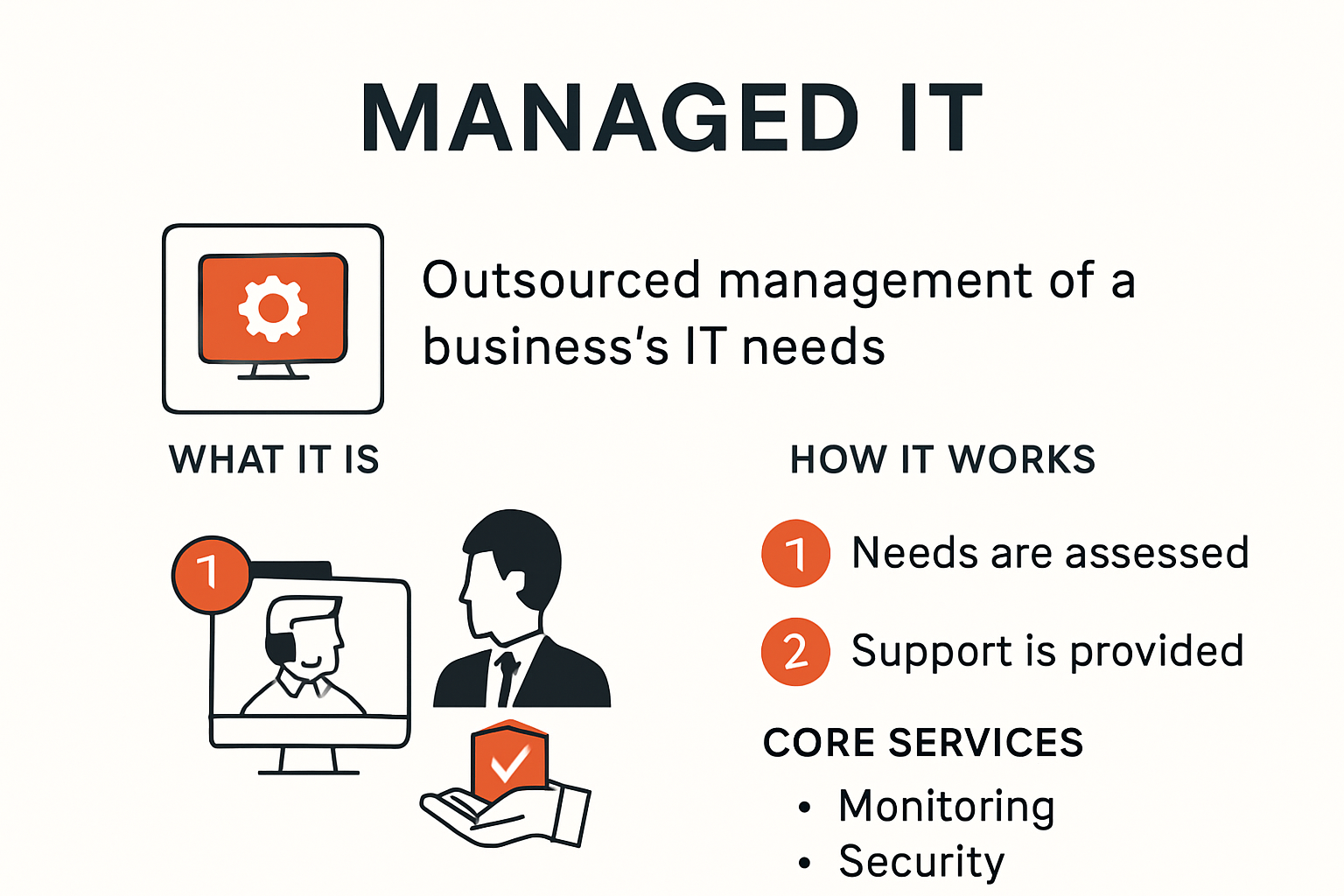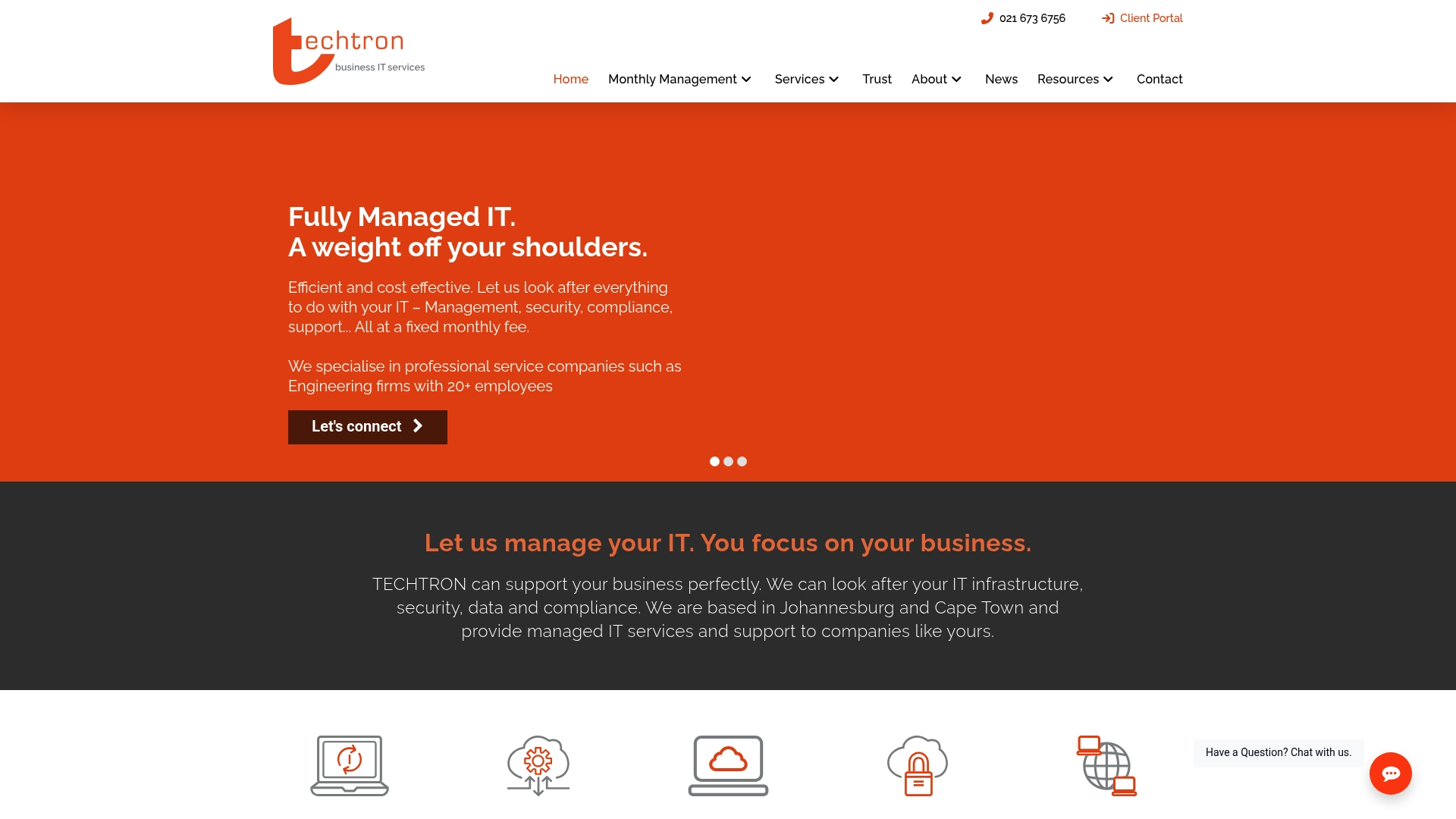What Is Managed IT? Complete Guide for Businesses 2025

Managed IT used to sound like something only big companies could afford and run. Now, more than 60 percent of small and medium-sized businesses trust managed IT partners to handle their networks, security, and support each month. Turns out, it is not just about fixing computers when something breaks. The real surprise is how it transforms unpredictable tech struggles into a smooth, strategic advantage that keeps your business moving forward.
Table of Contents
- Defining Managed IT And Its Core Services
- Key Benefits For Modern Businesses
- How Managed IT Supports Cybersecurity And Compliance
- Choosing The Right Managed IT Partner
Quick Summary
| Takeaway | Explanation |
|---|---|
| Strategic Cost Management | Managed IT services convert unpredictable technology expenses into consistent monthly payments, allowing for better budgeting and reducing large capital investments. |
| Access to Expertise | Businesses gain immediate access to specialized IT expertise without the need to maintain extensive in-house teams, enhancing agility and technological capabilities. |
| Proactive Security Measures | Managed IT services provide continuous monitoring and advanced threat detection, offering robust cybersecurity strategies that safeguard organizational assets effectively. |
| Thorough Partner Evaluation | Selecting the right managed IT partner involves assessing their technical expertise, support capabilities, and cultural alignment to ensure a successful collaboration. |
| Holistic IT Governance | Managed IT transforms IT from a cost center into a strategic business enabler by implementing comprehensive governance frameworks that align technological strategies with broader business objectives. |
Defining Managed IT and Its Core Services
Managed IT represents a strategic approach where businesses outsource their technology infrastructure and support requirements to specialized external providers. A managed IT service fundamentally transforms how organizations handle their technological ecosystems by transferring complex IT management responsibilities to expert third-party contractors.

Understanding the Core Concept
At its foundation, managed IT involves a comprehensive service model where providers assume complete responsibility for maintaining, monitoring, and optimizing an organization’s technological systems. These providers deliver proactive support through continuous monitoring, strategic planning, and rapid problem resolution. Unlike traditional break-fix models, managed IT focuses on preventing technological issues before they disrupt business operations.
Businesses typically engage managed IT services through monthly subscription arrangements, which provide predictable cost structures and access to enterprise-grade technological expertise. Research from educational technology experts suggest these services are particularly valuable for organizations seeking scalable, efficient technological management without substantial internal infrastructure investments.
Key Services in Managed IT
Managed IT encompasses a wide range of critical technological services designed to support business continuity and operational efficiency. These typically include:
- Network Management: Ensuring robust, secure, and high-performance network infrastructure
- Cybersecurity Protection: Implementing advanced threat detection and prevention mechanisms
- Cloud Solutions: Managing cloud migration, integration, and ongoing optimization
- Data Backup and Recovery: Developing comprehensive disaster recovery strategies
- Technical Support: Providing responsive helpdesk and troubleshooting services
By partnering with a managed IT provider, businesses can explore strategic service agreements that align technological resources with specific organizational objectives. This approach enables companies to focus on core business functions while maintaining cutting-edge technological capabilities.
The strategic value of managed IT extends beyond mere technical support. It represents a holistic approach to technological governance, transforming IT from a cost center into a strategic business enabler. Providers deliver not just reactive solutions but proactive technological roadmaps that anticipate and address potential challenges before they impact business performance.
To help clarify the variety of core services involved in Managed IT, the following table summarises and organises them:
| Service Area | Core Function | Business Benefit |
|---|---|---|
| Network Management | Maintain, monitor, & optimise networks | Reliable, secure connectivity |
| Cybersecurity Protection | Threat detection & prevention | Enhanced protection from cyber risks |
| Cloud Solutions | Manage cloud migration & integration | Scalable, efficient tech infrastructure |
| Data Backup & Recovery | Disaster recovery planning & execution | Business continuity, data integrity |
| Technical Support | Helpdesk & troubleshooting assistance | Quick problem resolution, less downtime |
Key Benefits for Modern Businesses
Modern businesses face increasingly complex technological challenges that demand sophisticated, flexible solutions. Managed IT services offer a strategic approach to addressing these challenges, providing comprehensive advantages that extend far beyond traditional IT support models.
Strategic Cost Management and Predictability

One of the most compelling benefits of managed IT services is financial predictability. According to TechRepublic, businesses can transform unpredictable technology expenses into consistent, manageable monthly investments. This approach eliminates unexpected repair costs and allows organizations to budget more effectively.
Traditional IT infrastructure requires substantial upfront capital and ongoing maintenance expenses. Managed IT services flip this model by offering scalable solutions where businesses pay for precisely the technological resources they need. This approach reduces capital expenditure and converts technology spending into a more flexible operational expense.
Enhanced Expertise and Technological Access
Research from Buchanan Technologies highlights that managed IT services provide businesses immediate access to specialized technological expertise. Small and mid-sized organizations often struggle to recruit and retain top-tier IT professionals. Managed service providers bridge this gap by offering comprehensive teams of experts who stay current with emerging technologies and cybersecurity trends.
By partnering with a managed IT provider, businesses gain access to advanced technological capabilities without maintaining extensive in-house teams. This model allows companies to leverage enterprise-grade technological resources that would otherwise be financially prohibitive. The result is a more agile, responsive technological infrastructure that can adapt quickly to changing business requirements.
Proactive Security and Risk Management
Cybersecurity represents a critical concern for modern businesses. Managed IT services offer robust, proactive security strategies that go beyond traditional reactive approaches. Providers continuously monitor networks, implement advanced threat detection mechanisms, and develop comprehensive disaster recovery plans.
The sophisticated security frameworks provided by managed IT services help businesses mitigate risks more effectively than traditional internal IT departments. These providers use advanced tools and methodologies to identify potential vulnerabilities, implement preventative measures, and respond rapidly to emerging threats.
Businesses can explore comprehensive security strategies that align with their specific operational requirements. By outsourcing complex security management, organizations can focus on core business objectives while maintaining robust technological defenses.
The strategic advantages of managed IT services extend far beyond simple technical support. They represent a holistic approach to technological governance that transforms IT from a cost center into a strategic business enabler. For modern businesses seeking efficiency, expertise, and competitive advantage, managed IT services offer a compelling solution to complex technological challenges.
How Managed IT Supports Cybersecurity and Compliance
Cybersecurity and regulatory compliance represent critical challenges for modern businesses, demanding sophisticated technological strategies and continuous vigilance. Managed IT services play a pivotal role in addressing these complex requirements by providing comprehensive security frameworks and proactive risk management approaches.
Comprehensive Cybersecurity Governance
Research from the University System of Georgia emphasizes that effective IT governance is fundamental to strengthening information security. Managed IT providers develop robust governance structures that systematically assess, monitor, and mitigate potential technological risks. This approach goes beyond traditional security measures by creating holistic frameworks that align technological strategies with broader business objectives.
These governance models typically involve annual cybersecurity evaluations, detailed risk assessments, and establishment of clear security management structures. By assigning explicit roles and responsibilities, managed IT services ensure that organizations maintain a disciplined and strategic approach to technological protection.
Advanced Threat Detection and Compliance Frameworks
According to a comprehensive study on cybersecurity frameworks, modern managed IT services integrate advanced technologies like Artificial Intelligence and Machine Learning to enhance real-time threat detection. These sophisticated tools enable proactive identification and neutralization of potential security vulnerabilities before they can be exploited.
Compliance represents another critical dimension of managed IT services. Different industries face unique regulatory requirements, ranging from financial services data protection guidelines to healthcare information privacy standards. Managed IT providers develop tailored compliance strategies that ensure organizations meet complex regulatory expectations while maintaining operational efficiency.
Strategic Risk Management and Continuous Monitoring
EDUCAUSE highlights that cybersecurity governance is a strategic approach involving comprehensive framework development, policy implementation, and resource allocation. Managed IT services transform this concept into practical, actionable strategies that protect organizational assets and maintain technological resilience.
Key components of this strategic approach include:
- Continuous Network Monitoring: Real-time surveillance of technological infrastructure
- Incident Response Planning: Predefined protocols for addressing potential security breaches
- Regular Security Audits: Systematic evaluations of existing security mechanisms
Businesses can explore advanced security frameworks that provide comprehensive protection tailored to specific organizational needs. By outsourcing these complex security requirements, companies can focus on core business objectives while maintaining robust technological defenses.
The strategic value of managed IT in cybersecurity extends beyond immediate protection. These services create adaptive, intelligent security ecosystems that evolve alongside emerging technological threats. For businesses seeking comprehensive, proactive technological protection, managed IT services offer an integrated solution that balances security, compliance, and operational flexibility.
For further clarity, the table below summarises key cybersecurity and compliance functions provided by managed IT services:
| Function | Description | Importance for Business |
|---|---|---|
| Cybersecurity Governance | Annual evaluations, risk assessment, frameworks | Strategic oversight and risk reduction |
| Threat Detection | AI/ML-based monitoring for vulnerabilities | Early warning, rapid response |
| Compliance Support | Industry-specific regulation alignment | Avoid fines, meet legal requirements |
| Incident Response Planning | Set procedures for security breaches | Minimise downtime and business impact |
| Regular Security Audits | Ongoing evaluation of security posture | Proactive improvement and accountability |
Choosing the Right Managed IT Partner
Selecting the appropriate managed IT partner represents a critical strategic decision that can significantly impact an organization’s technological capabilities and overall operational efficiency. The right partnership transforms technological management from a mere support function into a strategic business enabler.
Evaluating Technical Expertise and Experience
According to guidance from the New Zealand Ministry of Education, organizations must thoroughly assess a potential managed IT provider’s depth of experience and technical capabilities. This evaluation extends beyond surface-level credentials and requires a comprehensive understanding of the provider’s track record in handling technological challenges similar to your organization’s specific requirements.
Key indicators of technical expertise include demonstrated experience in your industry, documented case studies of successful technological transformations, and a proven ability to manage complex technological ecosystems. Businesses should request detailed portfolios that showcase the provider’s capability to handle sophisticated technological challenges and adapt to evolving technological landscapes.
Critical Selection Criteria
EdTech Magazine highlights several crucial factors that organizations must consider when selecting a managed IT partner. These include:
- 24/7 Support Capabilities: Ensuring continuous technological availability
- Scalability: Ability to grow and adapt with organizational needs
- Robust Security Frameworks: Comprehensive protection mechanisms
- Performance Monitoring Tools: Advanced tracking and optimization capabilities
Research from Technology Response Team emphasizes the importance of cost transparency and remote management capabilities. Organizations should seek providers who offer clear, predictable pricing models and demonstrate sophisticated remote support technologies that enable rapid response and minimal operational disruption.
Assessing Cultural and Strategic Alignment
Beyond technical capabilities, businesses must evaluate the potential managed IT partner’s cultural and strategic compatibility. This involves understanding their communication approach, responsiveness, and alignment with your organization’s broader technological vision.
Businesses can explore comprehensive service partnership options that provide flexibility and customization. The ideal managed IT partner should function as an extension of your internal team, offering proactive recommendations and strategic insights that drive technological innovation.
The selection process requires careful due diligence. Organizations should conduct comprehensive interviews, request detailed proposals, speak with existing clients, and potentially engage in pilot projects to assess the provider’s actual performance. Transparent communication, mutual understanding of expectations, and a shared commitment to technological excellence form the foundation of a successful managed IT partnership.
Ultimately, choosing the right managed IT partner is about finding a strategic collaborator who can transform technological challenges into competitive advantages. The most effective partnerships transcend traditional vendor-client relationships, creating integrated technological ecosystems that propel businesses towards their strategic objectives.
Frequently Asked Questions
What is managed IT?
Managed IT refers to the outsourcing of a business’s technology infrastructure and support to specialized external providers, allowing companies to focus on their core operations while benefiting from expert technological management.
What services are included in managed IT?
Managed IT services typically include network management, cybersecurity protection, cloud solutions, data backup and recovery, and technical support, all aimed at enhancing operational efficiency and business continuity.
How can managed IT benefit my business financially?
Managed IT transforms unpredictable technology expenses into predictable monthly payments, helping businesses manage their budgets more effectively and reducing the need for large capital investments in IT infrastructure.
How does managed IT improve cybersecurity?
Managed IT services provide proactive security strategies through continuous monitoring, advanced threat detection, and comprehensive disaster recovery plans, reducing the risk of cyber threats and enhancing overall organizational security.
Take Control of Your IT Challenges and Focus on Growth
Is unpredictable IT spending or the constant worry about cybersecurity keeping your business from reaching its full potential? If you identified with the pain points in What Is Managed IT? Complete Guide for Businesses 2025, such as unplanned costs, lack of technical expertise, or the pressure to stay compliant, then it is time to act. Managed IT is more than just support. It is a path to predictable costs, stability and business confidence. At Techtron, we know exactly what keeps professional firms up at night: uncertain budgets, compliance headaches and security threats that could strike at any time.

Ready to move past reactive IT fixes and finally achieve peace of mind? Explore our comprehensive IT solutions, designed for South African businesses with complex needs. We offer a true partnership and proactive support. Visit our landing page now and discover how we can help your organisation maintain compliance, ensure business continuity and outperform competitors. Contact us today and see what a trusted IT partner can do for your business.